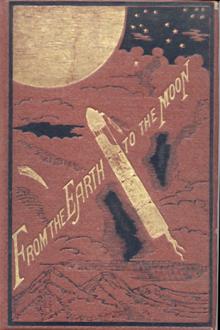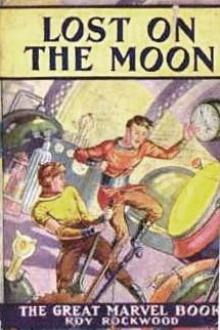From the Earth to the Moon, Jules Verne [online e book reading .TXT] 📗

- Author: Jules Verne
- Performer: -
Book online «From the Earth to the Moon, Jules Verne [online e book reading .TXT] 📗». Author Jules Verne
“Why? if weight on the moon’s surface is six times less than on the earth?” said Michel.
“But if the Selenites are six times smaller?” retorted Nicholl.
“And if there are no Selenites?” added Barbicane.
This put an end to the discussion.
Soon Eratosthenes disappeared under the horizon without the projectile being sufficiently near to allow close observation. This mountain separated the Apennines from the Carpathians. In the lunar orography they have discerned some chains of mountains, which are chiefly distributed over the northern hemisphere. Some, however, occupy certain portions of the southern hemisphere also.
About two o’clock in the morning Barbicane found that they were above the twentieth lunar parallel. The distance of the projectile from the moon was not more than six hundred miles. Barbicane, now perceiving that the projectile was steadily approaching the lunar disc, did not despair; if not of reaching her, at least of discovering the secrets of her configuration.
LUNAR LANDSCAPES
At half-past two in the morning, the projectile was over the thirteenth lunar parallel and at the effective distance of five hundred miles, reduced by the glasses to five. It still seemed impossible, however, that it could ever touch any part of the disc. Its motive speed, comparatively so moderate, was inexplicable to President Barbicane. At that distance from the moon it must have been considerable, to enable it to bear up against her attraction. Here was a phenomenon the cause of which escaped them again. Besides, time failed them to investigate the cause. All lunar relief was defiling under the eyes of the travelers, and they would not lose a single detail.
Under the glasses the disc appeared at the distance of five miles. What would an aeronaut, borne to this distance from the earth, distinguish on its surface? We cannot say, since the greatest ascension has not been more than 25,000 feet.
This, however, is an exact description of what Barbicane and his companions saw at this height. Large patches of different colors appeared on the disc. Selenographers are not agreed upon the nature of these colors. There are several, and rather vividly marked. Julius Schmidt pretends that, if the terrestrial oceans were dried up, a Selenite observer could not distinguish on the globe a greater diversity of shades between the oceans and the continental plains than those on the moon present to a terrestrial observer. According to him, the color common to the vast plains known by the name of “seas” is a dark gray mixed with green and brown. Some of the large craters present the same appearance. Barbicane knew this opinion of the German selenographer, an opinion shared by Boeer and Moedler. Observation has proved that right was on their side, and not on that of some astronomers who admit the existence of only gray on the moon’s surface. In some parts green was very distinct, such as springs, according to Julius Schmidt, from the seas of “Serenity and Humors.” Barbicane also noticed large craters, without any interior cones, which shed a bluish tint similar to the reflection of a sheet of steel freshly polished. These colors belonged really to the lunar disc, and did not result, as some astronomers say, either from the imperfection in the objective of the glasses or from the interposition of the terrestrial atmosphere.
Not a doubt existed in Barbicane’s mind with regard to it, as he observed it through space, and so could not commit any optical error. He considered the establishment of this fact as an acquisition to science. Now, were these shades of green, belonging to tropical vegetation, kept up by a low dense atmosphere? He could not yet say.
Farther on, he noticed a reddish tint, quite defined. The same shade had before been observed at the bottom of an isolated enclosure, known by the name of Lichtenburg’s circle, which is situated near the Hercynian mountains, on the borders of the moon; but they could not tell the nature of it.
They were not more fortunate with regard to another peculiarity of the disc, for they could not decide upon the cause of it.
Michel Ardan was watching near the president, when he noticed long white lines, vividly lighted up by the direct rays of the sun. It was a succession of luminous furrows, very different from the radiation of Copernicus not long before; they ran parallel with each other.
Michel, with his usual readiness, hastened to exclaim:
“Look there! cultivated fields!”
“Cultivated fields!” replied Nicholl, shrugging his shoulders.
“Plowed, at all events,” retorted Michel Ardan; “but what laborers those Selenites must be, and what giant oxen they must harness to their plow to cut such furrows!”
“They are not furrows,” said Barbicane; “they are rifts.”
“Rifts? stuff!” replied Michel mildly; “but what do you mean by `rifts’ in the scientific world?”
Barbicane immediately enlightened his companion as to what he knew about lunar rifts. He knew that they were a kind of furrow found on every part of the disc which was not mountainous; that these furrows, generally isolated, measured from 400 to 500 leagues in length; that their breadth varied from 1,000 to 1,500 yards, and that their borders were strictly parallel; but he knew nothing more either of their formation or their nature.
Barbicane, through his glasses, observed these rifts with great attention. He noticed that their borders were formed of steep declivities; they were long parallel ramparts, and with some small amount of imagination he might have admitted the existence of long lines of fortifications, raised by Selenite engineers. Of these different rifts some were perfectly straight, as if cut by a line; others were slightly curved, though still keeping their borders parallel; some crossed each other, some cut through craters; here they wound through ordinary cavities, such as Posidonius or Petavius; there they wound through the seas, such as the “Sea of Serenity.”
These natural accidents naturally excited the imaginations of these terrestrial astronomers. The first observations had not discovered these rifts. Neither Hevelius, Cassin, La Hire, nor Herschel seemed to have known them. It was Schroeter who in 1789 first drew attention to them. Others followed who studied them, as Pastorff, Gruithuysen, Boeer, and Moedler. At this time their number amounts to seventy; but, if they have been counted, their nature has not yet been determined; they are certainly not fortifications, any more than they are the ancient beds of dried-up rivers; for, on one side, the waters, so slight on the moon’s surface, could never have worn such drains for themselves; and, on the other, they often cross craters of great elevation.
We must, however, allow that Michel Ardan had “an idea,” and that, without knowing it, he coincided in that respect with Julius Schmidt.
“Why,” said he, “should not these unaccountable appearances be simply phenomena of vegetation?”
“What do you mean?” asked Barbicane quickly.
“Do not excite yourself, my worthy president,” replied Michel; “might it not be possible that the dark lines forming that bastion were rows of trees regularly placed?”
“You stick to your vegetation, then?” said Barbicane.
“I like,” retorted Michel Ardan, “to explain what you savants cannot explain; at least my hypotheses has the advantage of indicating why these rifts disappear, or seem to disappear, at certain seasons.”
“And for what reason?”
“For the reason that the trees become invisible when they lose their leaves, and visible again when they regain them.”
“Your explanation is ingenious, my dear companion,” replied Barbicane, “but inadmissible.”
“Why?”
“Because, so to speak, there are no seasons on the moon’s surface, and that, consequently, the phenomena of vegetation of which you speak cannot occur.”
Indeed, the slight obliquity of the lunar axis keeps the sun at an almost equal height in every latitude. Above the equatorial regions the radiant orb almost invariably occupies the zenith, and does not pass the limits of the horizon in the polar regions; thus, according to each region, there reigns a perpetual winter, spring, summer, or autumn, as in the planet Jupiter, whose axis is but little inclined upon its orbit.
What origin do they attribute to these rifts? That is a question difficult to solve. They are certainly anterior to the formation of craters and circles, for several have introduced themselves by breaking through their circular ramparts. Thus it may be that, contemporary with the later geological epochs, they are due to the expansion of natural forces.
But the projectile had now attained the fortieth degree of lunar latitude, at a distance not exceeding 40 miles. Through the glasses objects appeared to be only four miles distant.
At this point, under their feet, rose Mount Helicon, 1,520 feet high, and round about the left rose moderate elevations, enclosing a small portion of the “Sea of Rains,” under the name of the Gulf of Iris. The terrestrial atmosphere would have to be one hundred and seventy times more transparent than it is, to allow astronomers to make perfect observations on the moon’s surface; but in the void in which the projectile floated no fluid interposed itself between the eye of the observer and the object observed. And more, Barbicane found himself carried to a greater distance than the most powerful telescopes had ever done before, either that of Lord Rosse or that of the Rocky Mountains. He was, therefore, under extremely favorable conditions for solving that great question of the habitability of the moon; but the solution still escaped him; he could distinguish nothing but desert beds, immense plains, and toward the north, arid mountains. Not a work betrayed the hand of man; not a ruin marked his course; not a group of animals was to be seen indicating life, even in an inferior degree. In no part was there life, in no part was there an appearance of vegetation. Of the three kingdoms which share the terrestrial globe between them, one alone was represented on the lunar and that the mineral.
“Ah, indeed!” said Michel Ardan, a little out of countenance; “then you see no one?”
“No,” answered Nicholl; “up to this time, not a man, not an animal, not a tree! After all, whether the atmosphere has taken refuge at the bottom of cavities, in the midst of the circles, or even on the opposite face of the moon, we cannot decide.”
“Besides,” added Barbicane, “even to the most piercing eye a man cannot be distinguished farther than three and a half miles off; so that, if there are any Selenites, they can see our projectile, but we cannot see them.”
Toward four in the morning, at the height of the fiftieth parallel, the distance was reduced to 300 miles. To the left ran a line of mountains capriciously shaped, lying in the full light. To the right, on the contrary, lay a black hollow resembling a vast well, unfathomable and gloomy, drilled into the lunar soil.
This hole was the “Black Lake”; it was Pluto, a deep circle which can be conveniently studied from the earth, between the last quarter and the new moon, when the shadows fall from west to east.
This black color is rarely met with on the surface of the satellite. As yet it has only been recognized in the depths of the circle of Endymion, to the east of the “Cold Sea,” in the northern hemisphere, and at the bottom of Grimaldi’s circle, on the equator, toward the eastern border of the orb.
Pluto is an annular mountain, situated in 51@ north latitude, and 9@ east longitude. Its circuit is forty-seven miles long and thirty-two broad.
Barbicane regretted that they were not passing directly above this vast opening. There was an abyss to fathom, perhaps some mysterious phenomenon to surprise; but the projectile’s course could not be altered. They must rigidly submit. They could not guide a balloon, still less a projectile, when





Comments (0)